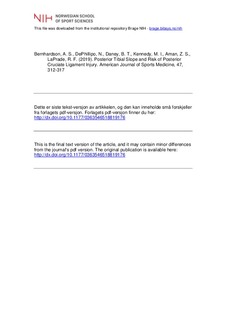| dc.contributor.author | Bernhardson, Andrew S. | |
| dc.contributor.author | DePhillipo, Nicholas | |
| dc.contributor.author | Daney, Blake T. | |
| dc.contributor.author | Kennedy, Mitchell I. | |
| dc.contributor.author | Aman, Zachary S. | |
| dc.contributor.author | LaPrade, Robert F. | |
| dc.date.accessioned | 2019-04-25T07:35:33Z | |
| dc.date.available | 2019-04-25T07:35:33Z | |
| dc.date.created | 2019-01-15T09:14:39Z | |
| dc.date.issued | 2019 | |
| dc.identifier.citation | American Journal of Sports Medicine. 2019, 47, 312-317. | nb_NO |
| dc.identifier.issn | 0363-5465 | |
| dc.identifier.uri | http://hdl.handle.net/11250/2595365 | |
| dc.description | I Brage finner du siste tekst-versjon av artikkelen, og den kan inneholde ubetydelige forskjeller fra forlagets pdf-versjon. Forlagets pdf-versjon finner du på sagepub.com: http://dx.doi.org/10.1177/0363546518819176 / In Brage you'll find the final text version of the article, and it may contain insignificant differences from the journal's pdf version. The definitive version is available at sagepub.com: http://dx.doi.org/10.1177/0363546518819176 | nb_NO |
| dc.description.abstract | Background: Recent biomechanical studies have identified sagittal plane posterior tibial slope as a potential risk factor for posterior cruciate ligament (PCL) injury because of its effects on the kinematics of the native and surgically treated knee. However, the literature lacks clinical correlation between primary PCL injuries and decreased posterior tibial slope. Purpose/Hypothesis: The purpose of this study was to retrospectively compare the amount of posterior tibial slope between patients with PCL injuries and age/sex-matched controls with intact PCLs. It was hypothesized that patients with PCL injuries would have a significantly decreased amount of posterior tibial slope when compared with patients without PCL injuries. Study Design: Case-control study; Level of evidence, 3. Methods: Patients who underwent primary PCL reconstruction without anterior cruciate ligament injury between 2010 and 2017 by a single surgeon were retrospectively analyzed. Measurements of posterior tibial slope were performed with lateral radiographs of PCL-injured knees and matched controls without clinical or magnetic resonance imaging evidence of ligamentous injury. Mean values of posterior tibial slope were compared between the groups. Inter- and intrarater agreement was assessed for the tibial slope measurement technique via a 2-way random effects model to calculate the intraclass correlation coefficient (ICC). Results: In sum, 104 patients with PCL tears met the inclusion criteria, and 104 controls were matched according to age and sex. There were no significant differences in age (P = .166), sex (P = .345), or body mass index (P = .424) between the PCL-injured and control groups. Of the PCL tear cohort, 91 patients (87.5%) sustained a contact mechanism of injury, while 13 (12.5%) reported a noncontact mechanism of injury. The mean ± SD posterior tibial slopes were 5.7°± 2.1° (95% CI, 5.3°-6.1°) and 8.6°± 2.2° (95% CI, 8.1°-9.0°) for the PCL-injured and matched control groups, respectively (P < .0001). Subgroup analysis of the PCL-injured knees according to mechanism of injury demonstrated significant differences in posterior tibial slope between noncontact (4.6°± 1.8°) and contact (6.2°± 2.2°) injuries for all patients with PCL tears (P = .013) and among patients with isolated PCL tears (P = .003). The tibial slope measurement technique was highly reliable, with an ICC of 0.852 for interrater reliability and an ICC of 0.872 for intrarater reliability. Conclusion: A decreased posterior tibial slope was associated with patients with PCL tears as compared with age- and sex-matched controls with intact PCLs. Decreased tibial slope appears to be a risk factor for primary PCL injury. However, further clinical research is needed to assess if decreased posterior tibial slope affects posterior knee stability and outcomes after PCL reconstruction. | nb_NO |
| dc.language.iso | eng | nb_NO |
| dc.subject | posterior cruciate ligament | nb_NO |
| dc.subject | tibial slope | nb_NO |
| dc.subject | radiographs | nb_NO |
| dc.subject | posterior knee instability | nb_NO |
| dc.title | Posterior Tibial Slope and Risk of Posterior Cruciate Ligament Injury | nb_NO |
| dc.type | Journal article | nb_NO |
| dc.type | Peer reviewed | nb_NO |
| dc.description.version | acceptedVersion | nb_NO |
| dc.source.pagenumber | 6 | nb_NO |
| dc.source.journal | American Journal of Sports Medicine | nb_NO |
| dc.identifier.doi | 10.1177/0363546518819176 | |
| dc.identifier.cristin | 1656784 | |
| dc.description.localcode | Seksjon for idrettsmedisinske fag / Department of Sport Medicine | nb_NO |
| cristin.unitcode | 150,34,0,0 | |
| cristin.unitname | Seksjon for idrettsmedisinske fag | |
| cristin.ispublished | true | |
| cristin.fulltext | postprint | |
| cristin.qualitycode | 2 | |
